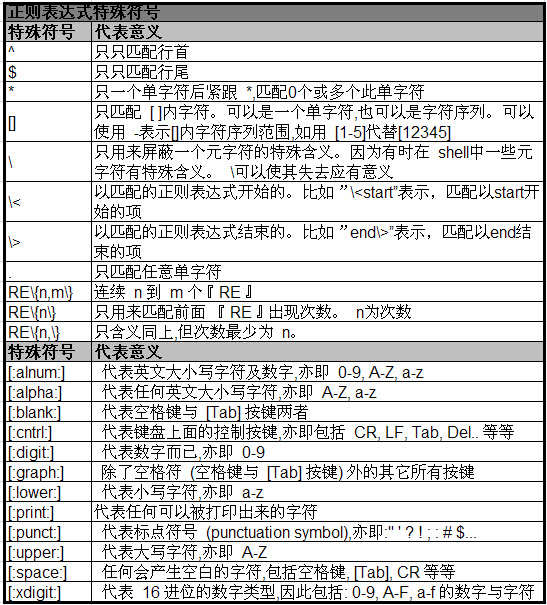本章主要通过一些应用实例,来对正则表达式进行说明。
1、正则表达式
正则表达式就是字符串的表达式。它能通过具有意义的特殊符号表示一列或多列字符串。
grep是linux系统下常用的正则表达式工具,可以使用grep来检索文本等输入流的字符串。
2、正则表达式特殊符号
参考下面表格

3、grep表达式
用法: grep [选项]... PATTERN [FILE]...
[root@winner ~]# grep --help
用法: grep [选项]... PATTERN [FILE]...
在每个 FILE 或是标准输入中查找 PATTERN。
默认的 PATTERN 是一个基本正则表达式(缩写为 BRE)。
例如: grep -i 'hello world' menu.h main.c
正则表达式选择与解释:
-E, --extended-regexp PATTERN 是一个可扩展的正则表达式(缩写为 ERE)
-F, --fixed-strings PATTERN 是一组由断行符分隔的定长字符串。
-G, --basic-regexp PATTERN 是一个基本正则表达式(缩写为 BRE)
-P, --perl-regexp PATTERN 是一个 Perl 正则表达式
-e, --regexp=PATTERN 用 PATTERN 来进行匹配操作
-f, --file=FILE 从 FILE 中取得 PATTERN
-i, --ignore-case 忽略大小写
-w, --word-regexp 强制 PATTERN 仅完全匹配字词
-x, --line-regexp 强制 PATTERN 仅完全匹配一行
-z, --null-data 一个 0 字节的数据行,但不是空行
Miscellaneous:
-s, --no-messages suppress error messages
-v, --invert-match select non-matching lines
-V, --version print version information and exit
--help display this help and exit
--mmap ignored for backwards compatibility
Output control:
-m, --max-count=NUM stop after NUM matches
-b, --byte-offset print the byte offset with output lines
-n, --line-number print line number with output lines
--line-buffered flush output on every line
-H, --with-filename print the filename for each match
-h, --no-filename suppress the prefixing filename on output
--label=LABEL print LABEL as filename for standard input
-o, --only-matching show only the part of a line matching PATTERN
-q, --quiet, --silent suppress all normal output
--binary-files=TYPE assume that binary files are TYPE;
TYPE is `binary', `text', or `without-match'
-a, --text equivalent to --binary-files=text
-I equivalent to --binary-files=without-match
-d, --directories=ACTION how to handle directories;
ACTION is `read', `recurse', or `skip'
-D, --devices=ACTION how to handle devices, FIFOs and sockets;
ACTION is `read' or `skip'
-R, -r, --recursive equivalent to --directories=recurse
--include=FILE_PATTERN search only files that match FILE_PATTERN
--exclude=FILE_PATTERN skip files and directories matching FILE_PATTERN
--exclude-from=FILE skip files matching any file pattern from FILE
--exclude-dir=PATTERN directories that match PATTERN will be skipped.
-L, --files-without-match print only names of FILEs containing no match
-l, --files-with-matches print only names of FILEs containing matches
-c, --count print only a count of matching lines per FILE
-T, --initial-tab make tabs line up (if needed)
-Z, --null print 0 byte after FILE name
Context control:
-B, --before-context=NUM print NUM lines of leading context
-A, --after-context=NUM print NUM lines of trailing context
-C, --context=NUM print NUM lines of output context
-NUM same as --context=NUM
--color[=WHEN],
--colour[=WHEN] use markers to highlight the matching strings;
WHEN is `always', `never', or `auto'
-U, --binary do not strip CR characters at EOL (MSDOS)
-u, --unix-byte-offsets report offsets as if CRs were not there (MSDOS)
‘egrep’即‘grep -E’。‘fgrep’即‘grep -F’。
直接使用‘egrep’或是‘fgrep’均已不可行了。
不带 FILE 参数,或是 FILE 为 -,将读取标准输入。如果少于两个 FILE 参数
就要默认使用 -h 参数。如果选中任意一行,那退出状态为 0,否则为 1;
如果有错误产生,且未指定 -q 参数,那退出状态为 2。
Report bugs to: bug-grep@gnu.org
GNU Grep 主页: <http://www.gnu.org/software/grep/>
GNU 软件的通用帮助: <http://www.gnu.org/gethelp/>
4、应用实例
下面以input.txt为例,对grep进行说明。input.txt的文本内容如下:
"Open Source" is a good mechanism to develop programs.
apple is my favorite food.
Football game is not use feet only.
this dress doesn't fit me.
However, this dress is about $ 3183 dollars.^M
GNU is free air not free beer.^M
Her hair is very beauty.^M
I can't finish the test.^M
Oh! The soup taste good.^M
motorcycle is cheap than car.
This window is clear.
the symbol '*' is represented as start.
Oh!
My god!
The gd software is a library for drafting programs.^M
You are the best is mean you are the no. 1.
The world <Happy> is the same with "glad".
I like dog.
google is the best tools for search keyword.
goooooogle yes!
go! go! Let's go
(01), 查找包含"the"的行,并显示行号。
$ grep -n "the" input.txt
说明:-n表示显示"行号"
(02), 不区分大小写,查找包括"the"的行,并显示行号。
$ grep -in "the" input.txt
说明:-n表示显示"行号";-i表示不区分大小写,即ignore大小写。
(03), 查找不包括"the"的行,统计行数。
$ grep -cv "the" input.txt
说明:-c表示统计(count);-v表示不匹配的项。
(04), 查找"当前目录"及其"所有子目录"中包含"the"的文件,并显示"the"在其中的行号。
$ grep -rn "the" .
说明:-r表示递归查找;-n表示显示行号。
(05), 查找匹配"t?st"的项,其中?为任意字符。
$ grep -n "t.st" input.txt
说明:.表示匹配任意字符
(06), 查找包含数字的行
$ grep -n "[0-9]" input.txt
或
$ grep -n "[[:digit:]]" input.txt
说明:[0-9]表示0-9之间的一个数字;[[:digit:]]也表示0-9之间的一个数字
(07), 查找以the开头的行
$ grep -n "^the" input.txt
说明:"^the"表示以the开头
(08), 查找以小写字母结尾的行。
$ grep -n "[a-z]$" input.txt
说明:[a-z]表示一个小写字母,$表示结束符;[a-z]$表示以小写字母结束的项。
(09), 查找空白行。
$ grep -n "^$" input.txt
说明:^表示开头,如^t表示以字母t开头;$表示结尾,如e$表示以e结尾。^$表示空白行。
(10), 查找以字母g开头的单词
$ grep -n "<g" input.txt
说明:<表示单词的开始,<g表示以g开始的单词。
(11), 查找字符串为go的单词。注意:不能包括goo,good等字符串
$ grep -n "<go>" input.txt
说明:<表示单词的开始,>表示单词结尾。<go>表示以字母g开头,以字母o结尾。
(12), 查找包括2-5个字母o的行。
$ grep -n "o{2,5}" input.txt
说明:pattern{n,m}表示n到m个pattern。o{2,5}表示2-5个字母o。
(13), 查找包括2个以上字母o(包括2个)的行。
$ grep -n "ooo*" input.txt
或
$ grep -n "oo+" input.txt
或
$ grep -n "o{2,}" input.txt
说明:
ooo*: 前面两个oo表示匹配2个字母o,后面的o*表示匹配0到多个字母o。
oo+: 第一个字母o表示匹配单个字母o;最后的"o+"一起发挥作用,其中,+是转义后的+,表示1到多个;而o+表示1到多个字母o。
pattern{n,}表示多于n个pattern。o{2,}表示多于2个字母o。
4 egrep
4.1 egrep说明
egrep是扩展的grep,即它的功能比grep更多一些。"egrep"等价于"grep -e"。
egrep相比与grep,支持括号"()"以及操作符"|"(表示或)。
4.2 egrep应用实例
仍然以上面的input.txt为输入文本进行说明
(01), 查找包含the或者this的行
$ egrep -n "the|this" input.txt
说明:-n表示输出匹配项的行号,"the|this"表示包括the或者包括this的项。
(02), 查找包含the或者this的行
$ egrep -vn "(the|this)" input.txt
说明:-n表示输出匹配项的行号,"the|this"表示包括the或者包括this的项;-v表示匹配的对立面。即 -v "the|this"表示既不包括the又不包括this的项。
